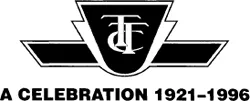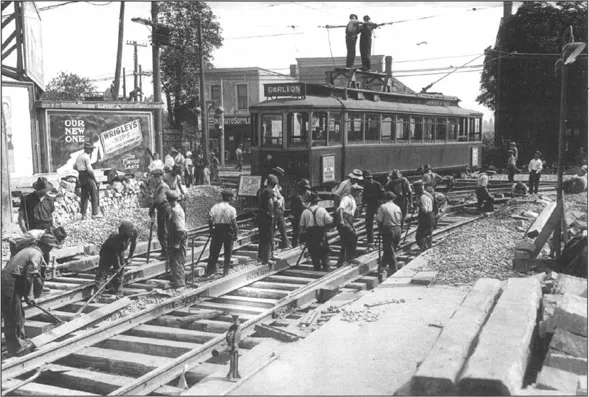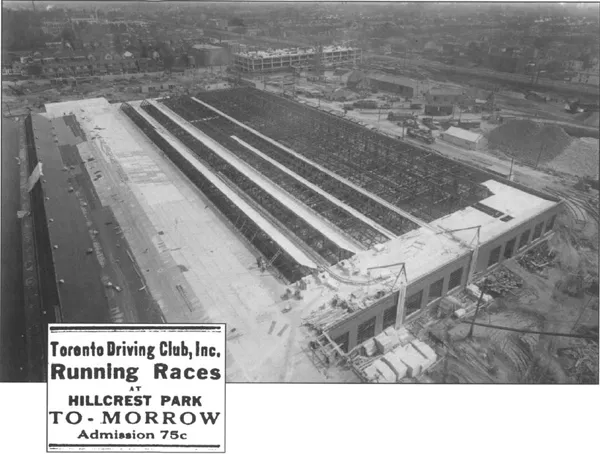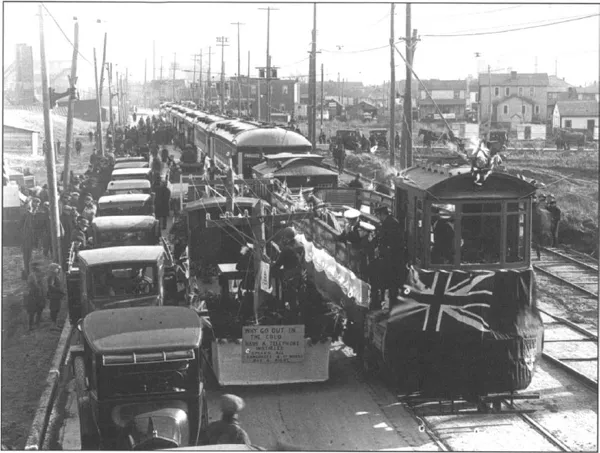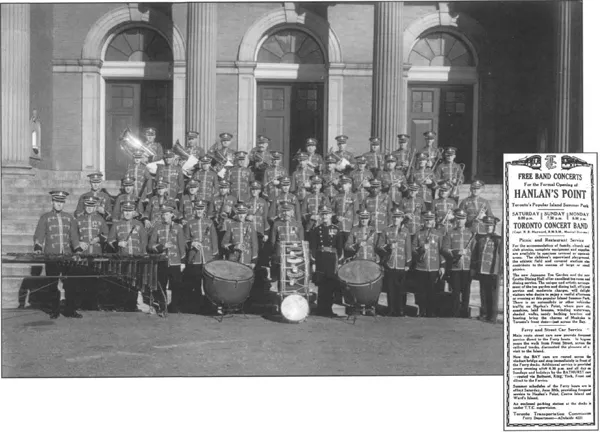![]()
THE TTC STORY
THE FIRST SEVENTY-FIVE YEARS
TRANS 173 AJP
Looking South on Coxwell Avenue to Queen Street on the day the new Toronto Transportation Commission “went into business.”
1921
Work on the rehabilitation of Toronto’s decrepit street railway system was well under way even before the new Toronto Transportation Commission officially assumed responsibility for municipal public transit on September 1, 1921. The TTC’s first construction project had actually commenced on July 26, 1921, at the corner of Danforth and Coxwell avenues when a crew of thirty men began laying a second track alongside a single track installed eight years earlier by the TTC’s precursor, the Toronto Civic Railways, to connect the Danforth with Gerrard Street. Work started at the north end of Coxwell since city crews were busy further south at the Queen Street corner widening that intersection. Once the Danforth-Gerrard section was completed, TTC crews began double-tracking the Gerrard–Queen stretch of Coxwell and on September 1, the date of this photogrpah, were busily installing the Queen-Coxwell switches. Work was completed on September 22, and on October 2, 1921, the TTC’s first new streetcar route, Coxwell, began operating over the new track.
TTC 61025 AJP
Newly acquired double-deck motor bus enters service on Humberside route.
Private entrepreneurs continued to offer transportation services in the outlying areas using vehicles like this “jitney bus” seen on Weston Road south of Eglinton Avenue.
1922
The Humberside motor bus route opened on September 20, 1921, and provided a connection between the streetcars on Dundas and the Runnymede Road district with buses operating on Humberside and High Park avenues and Annette Street. Prior to the introduction of the TTC’s first bus service on the new Humberside route, Torontonians had only ridden this kind of vehicle when a few enterprising citizens operated jitney buses during periods of labour unrest that had resulted in regular streetcar service being interrupted. Jitney comes from a slang word for a five-cent piece.
But while the TTC’s predecessor, the Toronto Railway Company, never operated buses during its thirty years in business, the concept of municipally owned motor buses had been seriously promoted as early as 1913 by Mayor Tommy Church. In an interview with The Evening Telegram newspaper that appeared in the August 16, 1919 edition, the mayor said:
At Board of Control meetings in 1913 and again in 1914, I stated that the day of the surface cars was limited and it would not be long before in some districts we would have trackless streets. I brought this matter before the Council during the debate on the proposed purchase of the Toronto Railway Company, but owing to the war and the financial situation it was laid over. The great bus system is bound to come in some districts to take the place of streetcars. I realize the price of gasoline and equipment is high at present, and wear and tear, but so is the price for streetcars. In certain sections of Toronto, where there is no other form of transportation, we could well experiment with buses. The recent street railway strike showed a large number of people how they could be readily transported by motor buses.
The buses to which the mayor was referring were the privately owned and operated jitney buses. The Commission was hesitant to embrace the motor bus when it took over public transportation operations in 1921. To gain experience in this new mode, especially in winter conditions, a handful of double deck buses was quickly acquired.
Double-deck bus number 7 seen in this photograph was built by the Associated Equipment Company of Great Britain and acquired by the TTC in early 1922. It was one of eight double-deck buses operated by the TTC. The open top deck quickly proved unsuitable for winter operations and before long this unique service was abandoned in favour of the regular “single-deck” bus. Number 7 was designed with a removable upper deck and it was destined to finish its brief career as a single-deck vehicle. The early buses assumed a feeder role to the high capacity streetcar lines. Today (1996), the TTC operates a fleet of more than fifteen hundred buses.
TTC 2060 AJP
The TTC begins rebuilding the city’s most complex track intersection.
1923
One of the most serious problems faced by officials of the new municipally owned Toronto Transportation Commission was the dilapidated condition of rolling stock, track, roadbeds, and numerous street railway intersections that had been the responsibility of the privately owned Toronto Railway Company until the 1921 take-over. It was painfully obvious that with the end of the TRC’s thirty-year franchise in sight, routine repairs had been placed low on the list of priorities. As a result, the TTC found it necessary to replace miles and miles of badly deteriorated and unsafe track. As well, during this rebuilding process, the “devil strip” (space between each direction of running tracks) had to be widened to permit the larger modern Peter Witt cars to safely pass.
Other major problems were found with the numerous track intersections, most of which were in various states of disrepair. The intersection shown in the photograph, King, Queen, Roncesvalles and Lake Shore Road, was described as one of the most complicated on the continent, and when acquired by the Commission was in dreadful condition. Following weeks of preliminary work, the first section of new rail was bolted into place at 12:31 a.m. on April 19, 1923. Less than five hours later the last section of what had amounted to more than three hundred tons of new rail was in place and the project finished in plenty of time to permit the morning rush hour cars to trundle through the rebuilt intersection.
Although streetcar service had resumed, concerns about proposed widening of the thoroughfares plus some road grading complications had resulted in the City Council of the day refusing to give permission for crews to pave the intersection. As a result vehicular traffic through the intersection was banned for a few more days.
TTC 2596 AJP
The TTC’s new Hillcrest general repair shops open this year.
A 1917 newspaper ad for “running races” held at the popular Hillcrest Race Track.
1924
Along with the acquisition of old streetcars and old streetcar tracks, the TTC also took over a collection of old, inefficient repair and maintenance facilities in the heart of the city. The Commission quickly decided to amalgamate these outdated facilities under “one roof,” or at least a collection of roofs in close proximity to each other. In 1922 a twenty-two-acre site, on the west side of Bathurst Street south of Davenport Road and adjacent to the tracks of the Canadian Pacific Railway, was selected primarily because it was at the geographical centre of 1920s Toronto. This location had formerly been the site of the McNamara farm on which, from 1912 until the Great War curtailed racing in 1917, the half-mile Hillcrest race track operated under the auspices of the Toronto Driving Club. During most of the track’s existence the McNamara family continued to cultivate a market garden in the middle of the track and kept growing produce up until the site was cleared for the new TTC structures.
In addition to the General Shops Building (seen under construction in the photograph and described in the literature of the day as “the largest, most modernly [sic] designed and equipped street railway shop under one roof in the world”), the new Davenport Garage for motor buses and a large stores building also occupied the sprawling site. Various TTC departments began moving into the new Hillcrest complex in mid-March with the last, the School of Instruction, arriving on June 9, 1924. Today the General Repair Shops is known as the D.W. Harvey Shops in honour of the TTC’s general manager from 1924 until his death on December 6, 1939. The magnitude of the new complex is evident in this October 3, 1923 photograph taken from the power and heating plant chimney.
TTC 4196 AJP
Weston route of the Township of York Railway opens.
1925
In an effort to provide better public transit throughout the city and into the outlying suburban communities, the newly established TTC undertook to integrate the various street railway services then in operation. One, the Toronto Civic Railways, was municipally operated while other routes were run by private entrepreneurs. An example of the latter was the Toronto Suburban Railway (TSR) with routes within the city’s boundaries in the northwest part of Toronto. Two of their routes traversed borders with track extensions terminating as far afield as Woodbridge and Guelph. In 1925, the TTC, acceding to a request from the Township of York, took over and operated under contract that portion of the TSR’s Weston line from its southern terminus at Keele and Dundas streets via Keele Street and Weston Road through the community at Mount Dennis to the north end of the Town of Weston. In total, the TTC operated four lines for the Township of York Railways (namely, Rogers, Oakwood, Weston, and the short-lived Lambton). The newspapers of the day referred to the new TTC/York Township partnership as providing the “emancipation [of the citizens] from the Suburban regime.” Vehicles participating in the official opening ceremonies of the new Weston route are seen northbound on Weston Road, November 28, 1925. Note the Bell Telephone Company “promo” on one of the parade floats.
TC 4558 AJP
Toronto Concert Bond.
A typical newspaper ad promoting the free TTC Band Concerts that featured the Toronto Concert Band, under the musical direction of Captain R.B. Hayward, and presented at Hanlan’s Point, “Toronto’s popular Island summer park.”
1926
Organized in 1925 by employees of the Toronto Transportation Commission, the Toronto Concert Band gave hundreds of concerts at venues such as Hygeia Hall on Elm Street, Hanlan’s Point, and Massey Hall before it was disbanded as an economy measure early in 1939. Throughout the band’s existence its sole conductor was English-born Richard Hayward (in dark uniform), a graduate of the Royal Military School of Music (Kneller Hall). Prior to emigrating to Canada in 1921, Hayward had been bandmaster of the Royal Irish Rifles. Soon after his arrival in Toronto he joined the famous Queen’s Own Rifles of Canada and served as the regimental band’s music director until 1928. He also taught at the Toronto Conservatory of Music, organized the Toronto Police Band, and for more than thirteen years conducted the TTC’s popular Toronto Concert Band. At ...

